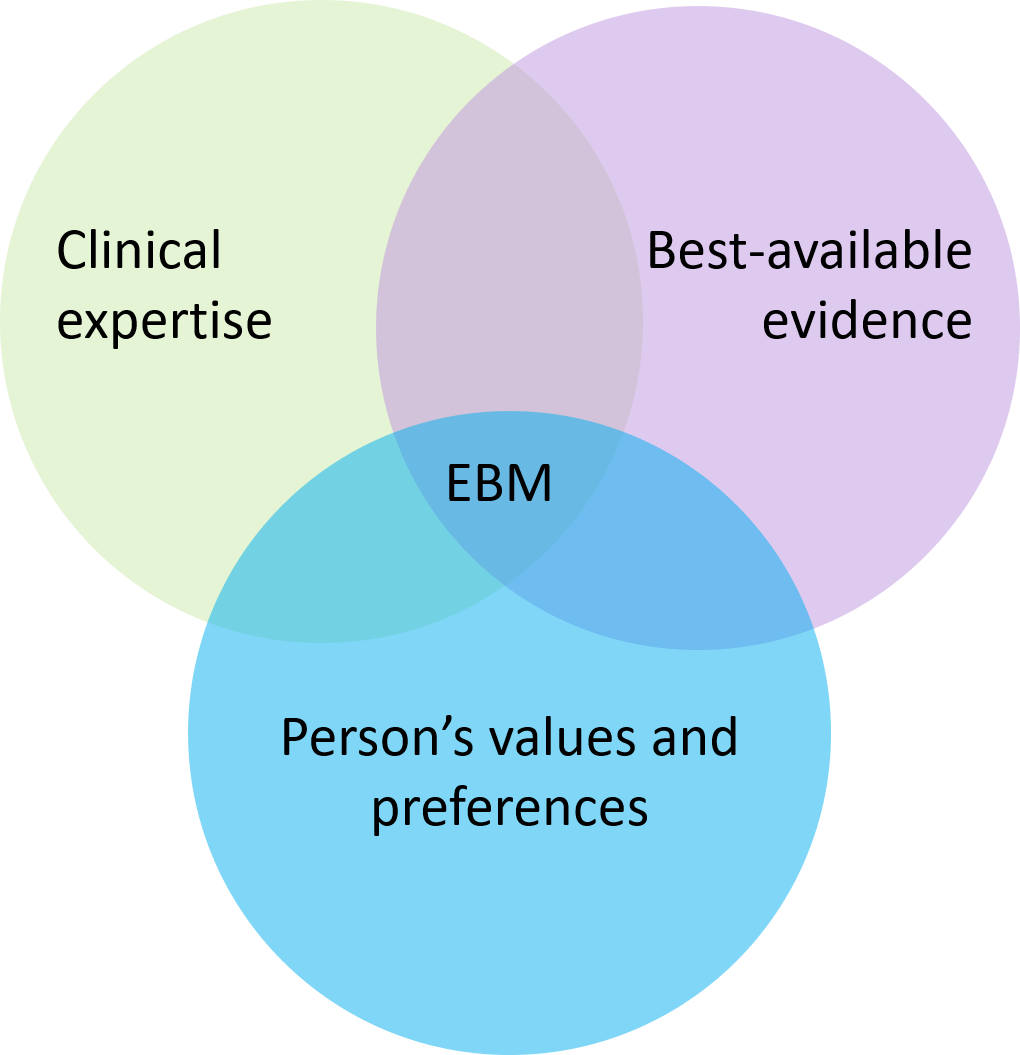Evidence-based medicine
What is evidence-based medicine?

Contrary to what some may think, evidence-based medicine (EBM) is not “one size fits all” medicine dictated by data, research, or statistics. Evidence certainly plays a pivotal role in EBM (hence the name), but evidence by itself is never enough.
In 1996, Sackett and colleagues offered a great description of what EBM is and isn’t, and their description remains just as accurate today as when they published it.1 Importantly, true EBM is medicine that utilizes the best-available evidence, clinical expertise, and – of great importance – a person’s values and preferences. It is only when these three elements are working together to the fullest extent possible that one is truly practicing EBM. Therefore, true EBM helps ensure optimized and individualized decisions for each person.
Shared decision-making
In the simplest sense, shared decision-making (SDM) is the “values and preferences” part of EBM. One could thus argue SDM is a necessary part of EBM. However, SDM is often discussed as an individual topic, so I also emphasize both in line with that convention.
“Nothing about me without me” is perhaps the simplest and most potent conceptualization of SDM, coming from Valerie Billingham in 1998 during the Salzburg Global Seminar Session Through the Patient’s Eyes: Collaboration between Patients and Health Care Professionals.2 Additionally, although not speaking directly to SDM, the movie Patch Adams — with Robin Williams as the namesake character — offers a poignant portrayal of the heart of medicine and the importance of maintaining proper focus (i.e., remembering patients are people, not just diagnoses or chief complaints). This was perhaps best expressed during a portion of the film when he offered the profound sentiment: “You treat a disease, you win, you lose. You treat a person, I guarantee you, you’ll win, no matter what the outcome.”3 This mindset is crucial to SDM. I have described SDM as a partnership between clinicians and their patients that involves clinicians: (1) informing their patients about their health/condition(s) and the evidence pertaining to the options available for management in a way that is understandable to them and (2) exploring and respecting their patients’ values and preferences in order to reach a personalized, informed decision about the best approach for their particular case.4 Although it’s much wordier than Billingham’s quote, I feel this is also a decently concise definition. Another good description comes from the National Learning Consortium (of the Office of the National Coordinator for Health Information Technology): “Shared decision making is a key component of patient-centered health care. It is a process in which clinicians and patients work together to make decisions and select tests, treatments and care plans based on clinical evidence that balances risks and expected outcomes with patient preferences and values.”.5 There are also other resources available that offer additional insights into SDM, coming from AHRQ, Mayo Clinic, Dartmouth, and NEJM.6
-
The paper is freely available now, and as such, I keep a copy of it on my website here (will open in new tab). ⧉ ↩︎
-
The website dedicated to this session is: https://www.salzburgglobal.org/multi-year-series/general/pageId/6381 .
An archived version is available at: https://web.archive.org/web/20230627034655/https://www.salzburgglobal.org/multi-year-series/general/pageId/6381 . ↩︎
-
See my page titled “The heart of medicine” for further demonstration of this concept within the movie Patch Adams. ↩︎
-
I did this within a paper I published in BMJ EBM, which is available for free here (the Editor-in-Chief selected it as an Editor’s Choice, which came with the benefit of rendering the article freely available to all): http://dx.doi.org/10.1136/ebmed-2016-110383 ↩︎
-
See their publication for further detail: https://www.healthit.gov/sites/default/files/nlc_shared_decision_making_fact_sheet.pdf
An archived version is available at: https://web.archive.org/web/20230716061809/https://www.healthit.gov/sites/default/files/nlc_shared_decision_making_fact_sheet.pdf . ↩︎
-
The following links are external and will open in a new tab. Each source has a “standard” link (URL pointing to live site) and an archived version (in case the site or current URL changes).
AHRQ: standard link , archived version
Mayo Clinic: standard link , archived version (formatting may be off)
Dartmouth: standard link , archived version
NEJM: standard link , archived link not applicable (it’s a journal publication) ↩︎